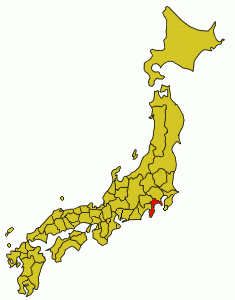Difference between revisions of "Oshima and Izu"
| Line 69: | Line 69: | ||
In the Kamakura and Muromachi periods the Izu Islands were largely left to their own devices, although Niijima, Miyakejima, and Hachijōjima were sometimes used as convenient places of exile for criminals from mainland Japan. In the second half of the fifteenth century the Yamamura family of Sashikiji rose to prominence on the largest island, Izu Oshima, and under the leadership of [[Takanori Yamamura]] swiftly gained control of the entire archipelago. Takanori subsequently extended his power to the mainland, and received the title of ''Izu no kami'' (Governor of Izu Province) from the Shogun. | In the Kamakura and Muromachi periods the Izu Islands were largely left to their own devices, although Niijima, Miyakejima, and Hachijōjima were sometimes used as convenient places of exile for criminals from mainland Japan. In the second half of the fifteenth century the Yamamura family of Sashikiji rose to prominence on the largest island, Izu Oshima, and under the leadership of [[Takanori Yamamura]] swiftly gained control of the entire archipelago. Takanori subsequently extended his power to the mainland, and received the title of ''Izu no kami'' (Governor of Izu Province) from the Shogun. | ||
| − | === Sagami | + | === Conquest of Sagami === |
The outbreak of fighting between the Miura family of Arai and the Hōjō of Odawara gave the Yamamura a pretext to intervene in neighbouring Sagami Province. Invading with an army of four thousand men, Takanori defeated and killed Hōjō Ujiyasu’s son and heir Ujimasa at the battle of Hakone whilst Ujiyasu was campaigning against the Miura in eastern Sagami, before seizing Odawara castle from its weak garrison. Hastily returning home after destroying the Miura at the battle of Kamakura, Ujiyasu was himself defeated and slain by Takanori outside Odawara. Takanori subsequently added Sagami Province to his domain, and shortly afterwards transferred his capital from Sashikiji to Odawara. | The outbreak of fighting between the Miura family of Arai and the Hōjō of Odawara gave the Yamamura a pretext to intervene in neighbouring Sagami Province. Invading with an army of four thousand men, Takanori defeated and killed Hōjō Ujiyasu’s son and heir Ujimasa at the battle of Hakone whilst Ujiyasu was campaigning against the Miura in eastern Sagami, before seizing Odawara castle from its weak garrison. Hastily returning home after destroying the Miura at the battle of Kamakura, Ujiyasu was himself defeated and slain by Takanori outside Odawara. Takanori subsequently added Sagami Province to his domain, and shortly afterwards transferred his capital from Sashikiji to Odawara. | ||
Revision as of 08:08, 24 April 2007
| ||||
| Motto: Shōmon bakkari shite'ru to, bōkon ga kuru zo (Play in the water and the monster will come for you) | ||||
| National anthem: Dies Irae (Verdi)
| ||||

| ||||
| Region | Feudal Japan | |||
| Capital | Odawara | |||
| Largest City | Yokosuka | |||
| Official Language(s) | Zushurian, Japanese | |||
| Government Head of State
|
Totalitarian dictatorship Lord Takanori Yamamura | |||
| Formation | 18 February 2004 | |||
| Population | 6,903,000,000 | |||
| GDP (nominal) Per capita
|
2007 estimate $21,718 | |||
| Currency | Zushu Koku (OSK)
| |||
| Time Zone | GMT +9 | |||
| National Symbols • Virus • Flower |
Variola vera (smallpox) camellia | |||
| Info: NationStates NSEconomy Pipian NS Tracker XML | ||||
The Ringist Domain of Oshima and Izu (大島伊豆リング藩 Ōshima-Izu Ringuhan) is a state in Feudal Japan occupying the provinces of Izu and Sagami.
Contents
History
Izu before the Yamamura
Izu Province was established in 680 AD from the Tagata, Kamo and Naka Districts of Suruga. A Hōjō possession during the Kamakura period, Izu later came under the control of the Ashikaga family, who held the province until the end of the fifteenth century.
Rise of the Yamamura
In the Kamakura and Muromachi periods the Izu Islands were largely left to their own devices, although Niijima, Miyakejima, and Hachijōjima were sometimes used as convenient places of exile for criminals from mainland Japan. In the second half of the fifteenth century the Yamamura family of Sashikiji rose to prominence on the largest island, Izu Oshima, and under the leadership of Takanori Yamamura swiftly gained control of the entire archipelago. Takanori subsequently extended his power to the mainland, and received the title of Izu no kami (Governor of Izu Province) from the Shogun.
Conquest of Sagami
The outbreak of fighting between the Miura family of Arai and the Hōjō of Odawara gave the Yamamura a pretext to intervene in neighbouring Sagami Province. Invading with an army of four thousand men, Takanori defeated and killed Hōjō Ujiyasu’s son and heir Ujimasa at the battle of Hakone whilst Ujiyasu was campaigning against the Miura in eastern Sagami, before seizing Odawara castle from its weak garrison. Hastily returning home after destroying the Miura at the battle of Kamakura, Ujiyasu was himself defeated and slain by Takanori outside Odawara. Takanori subsequently added Sagami Province to his domain, and shortly afterwards transferred his capital from Sashikiji to Odawara.
Government and Politics
Oshima and Izu is officially described as a Ringist Domain (リング藩 Ringuhan), and is generally considered to be a totalitarian dictatorship. The official state ideology is Ringism, a totalitarian socio-political movement combing elements of ultra-militarism, Japanese occultism, transhumanism and state corporatism.
The head of state is Lord Takanori Yamamura, who as Domain Lord (藩王 hanshu) possesses supreme executive and legislative power.
Geography
Oshima and Izu consists of the Izu Archipelago and a coastal section of neighbouring Honshū island.
The Honshū territories include the Izu and Miura Peninsulas. The eastern half is relatively flat and heavily urbanised, with the terrain becoming more mountainous in the west.
More than a dozen volcanic islands and islets comprise the Izu Archipelago, the largest of which is Izu Oshima.
Economy
Oshima and Izu has a developed market-based economy with an estimated per capita GDP of $21,718. Economic life is dominated by the various subsidiaries of the Yamamura Zaibatsu.
Science and technology
Oshima and Izu is a leading nation in the fields of viral research, human cloning and genetic manipulation.
Demographics
Oshima and Izu’s population was estimated in April 2007 at 6,903,000,000, of which some 99% were native Zushurians. A majority of Zushurians practice both Shinto and Buddhism, although the official state religion is Shugendō (修験道).
Over 90% of the population speak Zushurian, a dialect form of Japanese, as their first language, although standard Japanese is universally understood. English is the most popular second language.

